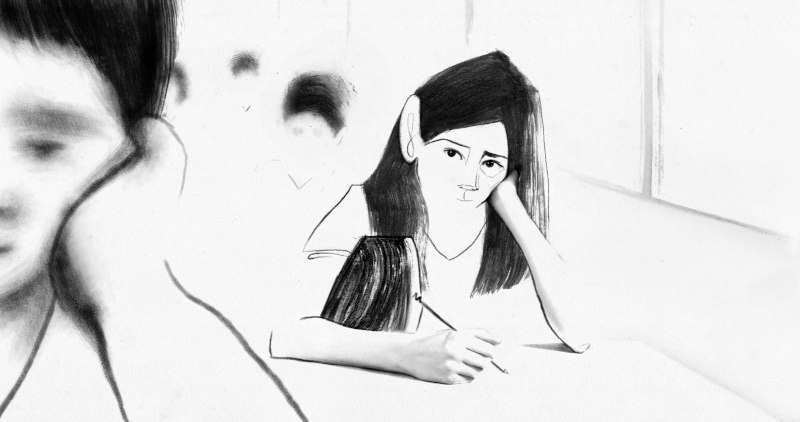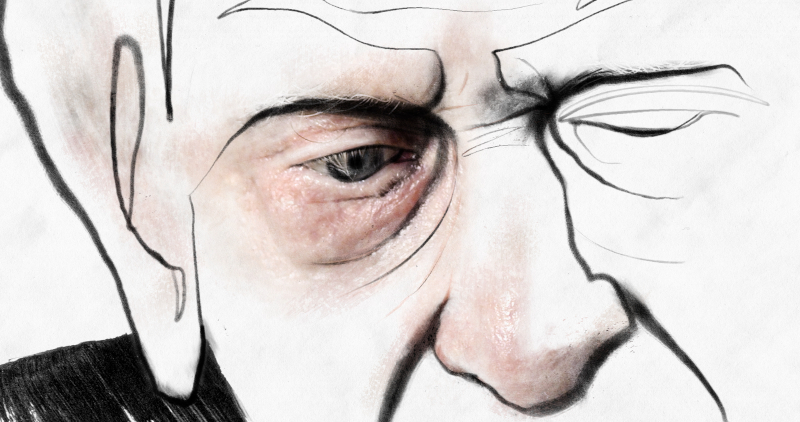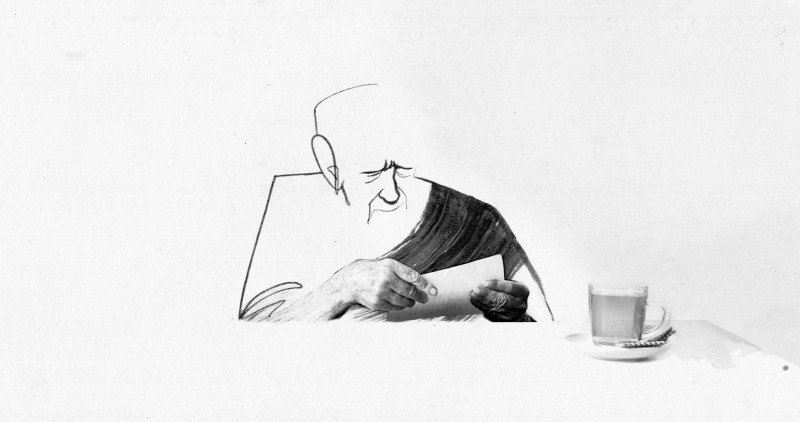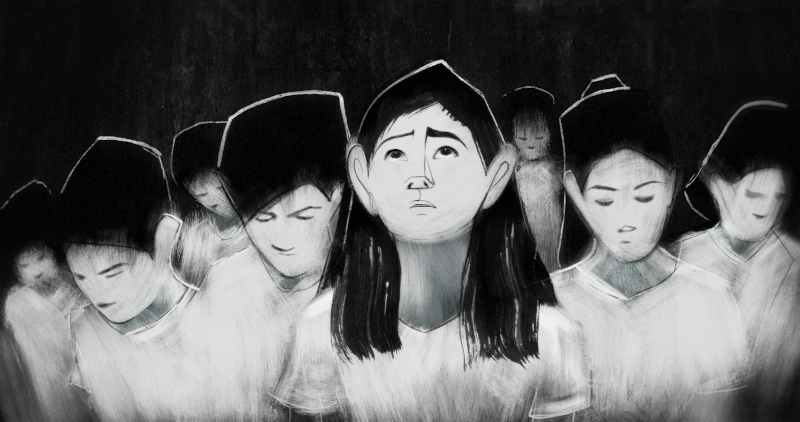Director – Tal Kantor – 2022 – France, Israel – 17m
*****
Under the watchful eye of an authoritarian teacher, as a class of bored teenagers listens to a visiting Holocaust survivor recount his experiences, one of their number daydreams about the pig with which the survivor shared a barn – nominated for Best Animated Short at the 2024 Academy Awards, VoD details below review
A figure (voice: Indra Maharik) with one shoe flees, running through a forest. “Nothing mattered”, says the old man sitting, his hands clasped together on the desk, in front of the schoolroom of bored Israeli teenagers. Haim (voice: Alexander Peleg) is recounting his experiences under the Nazi regime, but the teenagers would rather be somewhere else. Haim tells how he fled to a barn, where the pig there effectively saved his life. The severe teacher (voice: Ayelet Margalit) ejects one of them for remarking, “oink, oink”. Haim, recounting the past, talks about people capable of hate not deserving to live; he has clearly been unable to forgive those who acted on behalf of the Nazi regime.

Drifting off into a reverie, in her mind’s eye, one girl (voice: Moriyah Meerson) sees the SS send a pig to pursue the boy through the forest. Spouting a slightly, pig-like nose, she and others follow its pursuit. She finds herself going through a labyrinthine network of corridors and rooms, where they confront the now giant pig, acting like a lynch mob and stringing it up on the chandelier. However, her reaction to the pig is more complex, and it starts to morph: now the size of a human baby, she cradles it in her arms; now the size of a Lilliputian, she lets it leave the house through an opening to graze contentedly outside.
Letter to a Pig uses both archetypes and dream imagery in its groundbreaking approach. It also uses the media of both film and animation in a highly innovative way.

Its Holocaust survivor, an old man who has clearly suffered much and wants to communicate that to others, may be sincere in his intentions, but – on another level entirely – could be seen by teenagers as a “boring old fart” (my choice of words) and of no interest to listen to. The teens, after all, are not in class because they want to be there; they are there because the state requires their attendance. This situation is reinforced by a teacher meting out discipline in an attempt to maintain order. However, such a captive audience setup is scarcely likely to inspire attentive listening.
Prior to the animation process being executed, live action actors were photographed against a green screen. There is a long tradition of repurposing live action in animation, going right back to classic techniques such as rotoscoping (basically, tracing off frames of live action movement to rework the moving images in animation). The current green screen technique allows for highly complex treatment of live action footage by, for instance, having one part of a character represented on the screen in live action and others in drawn animation elements.

The Holocaust survivor’s hands, for example, are live action, spending much of the time resting still on the desk at which he is seated, but his torso and face, which move expressively as he verbally describes his experiences, are conveyed minimally as simple lines. This creates a fractured or disjointed effect, a perfect visual and kinetic metaphor for someone who has undergone trauma.

A similar effect is used in the representation of the schoolgirl, who is augmented with a snout and enlarged ears ever so slightly reminiscent of a pig. At one point, her live action eyes stare through a complex wooden lattice, suggesting her being trapped or encased within a world which is closed up, barred and restricted.
Even more compelling is the portrayal of the pig as it shifts from Nazi servant to gargantuan monster to helpless infant to grazing wild animal. It implicitly carries a whole set of cultural references as varied as George Orwell’s Animal Farm, Pink Floyd’s flying pig balloon, Beatrice Potter’s children’s stories and, for that matter, the children’s TV show Peppa Pig. It’s rendered in a number of different styles, including one where its underbelly is heavily drawn and shaded while its horizontal back is not shown, a white mass that is mentally filled in by the viewer’s brain.
Overall, this short is a highly effective exploration of some very difficult and almost taboo subject matter. To say, for instance, that you find the Holocaust survivor to whom you’re listening to be boring sounds like a complete cultural faux pas, yet if you force kids to listen to such people in the context of the classroom, such reactions must surely occur. To place a character in this scenario and then allow them to free associate images from this starting point seems dangerous indeed. Yet, working from this premise, Kantor’s film delivers something quite remarkable.
Letter to a Pig is nominated for Best Animated Short at the 2024 Academy Awards. VoD details below.
Trailer:
The making of Letter to a Pig:
Rent for £3.99 on VoD:
